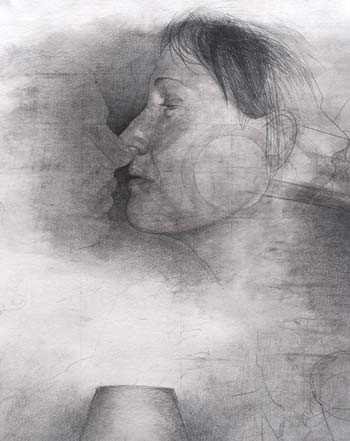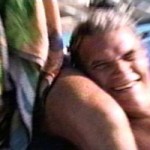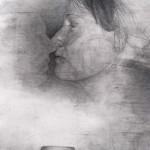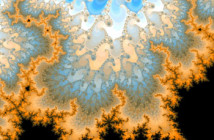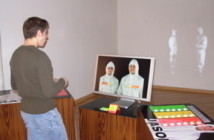After, the current exhibition at the Mills Gallery curated by Laura Donaldson, seeks to initiate a conversation about our pivotal responses to Loss. Speaking mostly in distanced elegiac tones, the exhibition stakes its primary ground in the shrouded territory of shadows. Entering the space, we hear the small, mournful drone of a woman sobbing. Julie Roberts’ video, She’s gone…she’s gone reveals that all-too-familiar interior place that is afraid to let us go. This site is ground zero for a very particular take on the concept of After. It echoes the worldview of a culture whose private eyes are almost hypnotically fixed on the rearview mirror, unwilling to be torn from the aftermath of a Grande Collective Trauma, yet unable to summon a compelling forward vision. The underlying current coursing through the lion’s share of the work included in the exhibition betrays a deeply seated collective fear that if we fail to hold on to memories of our lost loves, perhaps nothing will remain.
An exception to the somber pallor is the intimate bubble bursting video by Mary Magsamen and Stephen Hillerbrand. Here, understated humor is employed as a powerful and effective tool. We watch with knowing eyes for the moment when the precarious bubble reaches its crescendo and we watch as the slapstick gum residue is calmly unstuck from the deadpan face of its human recipient. Life goes on. Shared intimacy and the physical exchange of breath are central to the cycle. David Politzer’s Mount Rushmore video offers us two strikingly diverse ways to wrap our heads around impermanence. The powerful monumentality exercised by the weight of our remembered past is summoned by footage of a pilgrimage vacation to Mount Rushmore. This scenario functions as a backdrop for the private social events surrounding a death in the family which occurred just after the return from the pilgrimage. This video compassionately allows room for the inevitable mortal confusion brought on by death while nudging us toward a larger view of our earthly endeavors. At one point the white on black text remarks, “I tried to smile…I wanted to say something that would make everyone feel better…” Politzer refuses to sulk and offers no easy answers. Rather, he attends to our immediate need for comfort and comradery, life and afterlife, small talk and monumentality. Emily Puthoff evokes a distant, grainy, strangely lovely place through a kind of keyhole voyeurism made possible by a curious elegant wooden wondercabinet with slender brass legs, set on a carved foam faux rock platform. The soundwaves of Siren bear traces of hauntingly poignant voices, as we are cajoled from traces of the remembered past to vistas of a strange new horizon.
In a contrasting tone, Autumn, a single channel video by Jonathan Whitehall, opens in an almost deserted park. The dim light is failing and the ground is covered with dry leaves. The tone of the narrator’s voice is faded and sad. He confesses loneliness, the impossibility of love, the frailty of the body. He whispers that he has stopped thinking, that this is all he can do now. Jake Bloomer’s tender Crocodile Tear Reservoir drawing also dwells in a ghostly achromatic remembered zone, as does Gary Duehr’s Falling, and Flood, a large drawing by Kimi Weart that skillfully tweaks distant memories of Noah’s arc. Here, no sign of the dove with the olive branch is offered to us, as all signs of earthly life, rendered without chromatic color, stoically navigate the devastation and debris. In another version of Flood, Julie Levesque allows us an uncanny bird’s eye view of a whitewashed, waterlogged town overlaid with distant voices belonging to sunny backyard dramas of yesteryear. The miniature scale of the ordered little neighborhood, once teeming with lemonade stands and bicycles, gives pause as it poetically emanates a chalky, deeply somber graveyard resonance. Folds, a series of digital prints by Andrew Johnson responds to the consequences of crises in the Middle East by expressing images of an endless war, where black is made white and there is no ever after.
Images of waves, birds flying in vast empty spaces, whitewashed surfaces, and whispered strains permeate the space of the Mills Gallery. One wonders what happened to all the color in the Big Picture of After. Misa Saburi uses white as a purifying antidote signifying a quiet emotion in Nagoriyuki, a Japanese word for snow remaining on the ground in early spring. Her small, wooden, doll like sculptures seek to communicate a sense of universal calmness in the aftermath of an experience. In order to cultivate a sense of what is next, it is worthwhile examining what after is before – what comes next – while processing our memories and acknowledging the fruits of our actions.
What can be said about projecting the forward thrust of our imaginative vision? In the wake of our mourning, have we lost sight of the necessity to create the continually evolving infrastructure of our future lives? We can learn that we see what we look for. Our obsessive returning to the shadows of introspection exacts a high toll if we choose to dwell in the bosom of the wake. In a way, it is comfortable. It is a known place. But it is worn out and tired. It is OK to let go. We can bury our dead, honor our memories, and blow new bubbles together.
Links:
Mills Gallery
"After" is on view February 3 - March 19 at the Mills Gallery.
All images are courtesy of the artist and the Mills Gallery.

